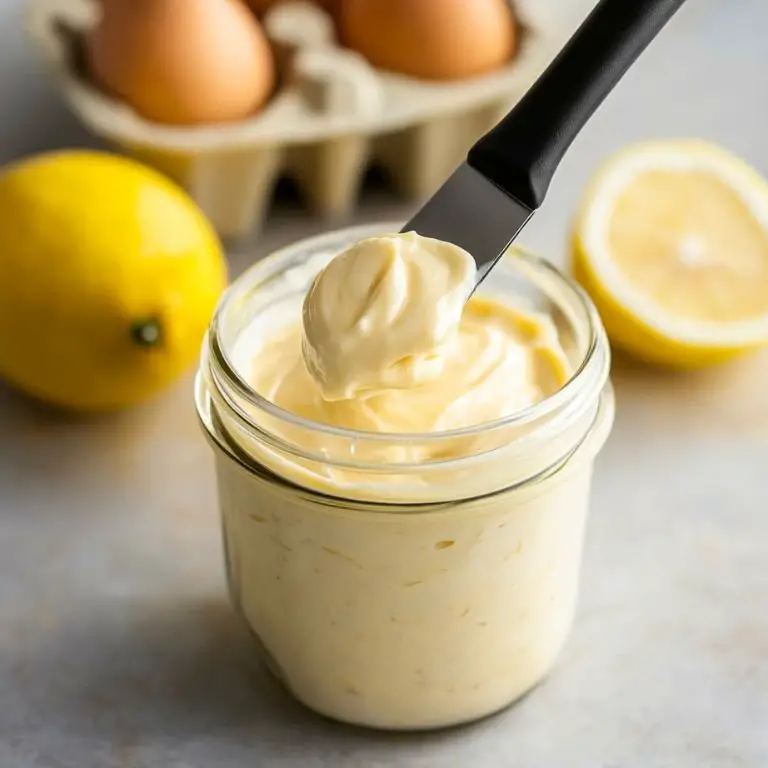Homemade mayonnaise might sound intimidating, but trust me—once you make it yourself, there’s no turning back. This particular version, featuring fresh eggs and bright lemon juice, yields a smooth and creamy mayo that puts store-bought jars to shame. Whether you're dressing a salad, slathering it on a sandwich, or whisking it into a rich mayonnaise sauce, this diy mayonnaise recipe delivers fresh, vibrant flavor with only a handful of ingredients. It's the kind of foundational condiment you’ll keep coming back to—versatile enough for countless mayonnaise recipes dishes and rich enough to shine on its own.
Homemade Mayonnaise with Eggs and Lemon
Prep Time 5 minutes mins
Total Time 5 minutes mins
Course Condiment
Cuisine American, French
Servings 16 makes about 1 cup
Immersion blender This is hands-down the easiest and most foolproof way to make mayonnaise. It blends and emulsifies everything right in the jar.
Wide-mouth mason jar or a tall container Make sure it fits your immersion blender snugly. This keeps all the ingredients concentrated at the base during blending.
Measuring Spoons For accurate seasoning and acid ratios.
Optional: Food processor or standard blender These work too, though they're slightly trickier to control and require a slow drizzle of oil.
- 1 large egg room temperature – The base of your emulsion. Pasteurized eggs are recommended for food safety.
- 1 tablespoon Dijon mustard – Adds tang and helps stabilize the emulsion.
- 1 tablespoon fresh lemon juice – Brightens the flavor and adds acidity to balance the richness.
- 1 cup light olive oil or neutral oil – For an olive oil mayonnaise recipe use light olive oil for a mild flavor, or try half olive oil and half avocado oil for a smooth finish.
- 1/2 teaspoon fine sea salt – Enhances the overall flavor.
- Optional: pinch of white pepper or a splash of apple cider vinegar – For a little extra complexity.
Start with Room Temperature Ingredients
This is crucial. Cold eggs and oil can cause the emulsion to break. Let your egg and lemon juice come to room temp before starting.
Add Ingredients in the Right Order
Into your wide-mouth jar, add: 1 egg, 1 tablespoon Dijon mustard, 1 tablespoon lemon juice, and 1/2 teaspoon salt. Pour in 1 cup of light olive oil last. Do not stir or mix yet.
Insert Immersion Blender
Place your immersion blender all the way at the bottom of the jar. Hold it still and start blending. After about 10 seconds, you'll see the mayo forming at the base.
Slowly Lift the Blender
As the emulsion forms, gently lift the blender upwards to incorporate the remaining oil. In about 20–30 seconds, you’ll have thick, creamy mayonnaise.
Taste and Adjust
Add more lemon juice or salt if needed. If you want a tangier mayo, consider a splash of apple cider vinegar.
Store It Right
Transfer the mayo into a clean jar with a lid. It will keep in the fridge for up to 1 week. Label it with the date—homemade mayo doesn't have preservatives like store-bought versions.
Pairings in Detail
This homemade mayo is a kitchen workhorse. Here are a few tasty ideas to put it to work:
- Mayonnaise Sandwich: Mix with fresh herbs and spread generously between slices of toasted sourdough with sliced tomato and cucumber.
- Mayonnaise Chicken Recipe: Coat chicken thighs in mayo, garlic, and breadcrumbs before baking. The result? Crisp, juicy chicken with a golden crust.
- Potato or Egg Salad: Use as the base for a classic salad—add pickles, celery, and a dash of paprika for extra punch.
- Dressing Base: Turn your mayo into ranch, aioli, or a zippy coleslaw dressing with just a few tweaks.
- Mayonnaise Sauce: Combine with sriracha, honey, or curry powder for dipping sauces that elevate any dish.
- Burger Binder: Mix into ground meat for moist and flavorful burgers before grilling.
It’s also a great alternative in Dukes Mayonnaise recipes or Hellman's Mayonnaise recipe ideas if you're experimenting with homemade variations.
FAQs
1. Can I use raw eggs safely in this mayo recipe homemade style?
Yes, but it’s best to use pasteurized eggs to minimize the risk of salmonella. Most grocery stores carry them. If you’re extra cautious, you can even pasteurize them at home using a sous vide method.
2. Can I make this mayo without an immersion blender?
You can. Use a food processor or standard blender, but you'll need to drizzle the oil in very slowly to avoid breaking the emulsion. It’s a little more labor-intensive but still doable. Hand-whisking is possible but requires serious elbow grease.
3. Can I use extra virgin olive oil instead?
Technically yes, but it's not ideal. Extra virgin olive oil has a bold, sometimes bitter flavor and can overpower the mayo. Stick to light olive oil or a blend for the best taste and texture.
4. Can I customize the flavor?
Absolutely! Add minced garlic for a garlicky aioli, chipotle powder for smokiness, or fresh herbs like dill and tarragon for a garden-fresh twist. Once you've nailed the base, this opens the door to hundreds of diy mayonnaise recipes.
5. How can I fix broken mayo?
Don’t panic! If your mayo separates or looks runny, add a new egg yolk to a clean bowl and slowly whisk in the broken mixture until it re-emulsifies. It’s like magic—and it saves the batch.
